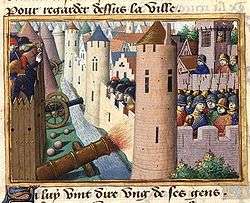Siege of Rouen
| Siege of Rouen | |||||||
|---|---|---|---|---|---|---|---|
| Part of the Hundred Years' War | |||||||
 The siege of Rouen in 1419 (illustration from Vigiles de Charles VII) | |||||||
| |||||||
| Belligerents | |||||||
|
|
| ||||||
| Commanders and leaders | |||||||
|
| Guy Le Bouteiller | ||||||
At the time of the Siege of Rouen (July 1418 – January 1419), the city had a population of 70,000, making it one of the leading cities in France, and its capture crucial to the Normandy campaign during the Hundred Years' War.
From about 1415, Rouen had been strengthened and reinforced by the French and it was the most formidably defended place that the invaders had yet faced.
When the English reached Rouen, the walls were scattered with many towers and guns, and lined by an army of crossbow men under the command of Alain Blanchard, commander of the crossbows (arbalétriers), and second in command to Guy LeBouteiller, the overall commander.
Due to a lack of manpower on the English side, a "breach and storm" of the city could not be managed so the town was completely surrounded, with the English intending to starve out the defenders. By December, the people of Rouen were eating cats, dogs, horseflesh, and even mice. The streets were filled with starving citizens. The town expelled more than 12,000 of the poor to save food. King Henry V would not allow the people to leave the siege line, and so the starving, expelled people of Rouen were forced to live in the ditch dug near the wall of Rouen for Rouen's protection. Even the English felt sorry for the starving people. On Christmas Day 1418, King Henry allowed two priests to give food to the starving people, but the day soon ended and the people went back to dying miserably in the ditch.
Despite several brave sorties led by the French garrison, this state of affairs continued until the French surrender on 20 January 1419. Alain Blanchard, who had executed English prisoners, was executed by the English when the town fell.
After the city fell, many of the inhabitants were so sick of both the Duke of Burgundy and the dauphin that they swore allegiance to Henry.
Henry went on to take all of Normandy, apart from Mont St. Michel, which withstood blockade for 21 years, until it was relieved by the French reconquest.
Coordinates: 49°26′24″N 1°05′38″E / 49.44000°N 1.09389°E